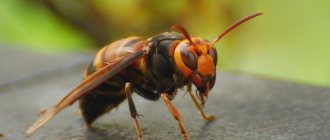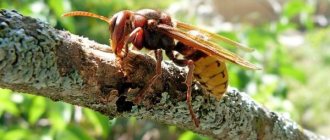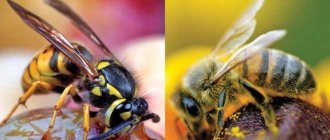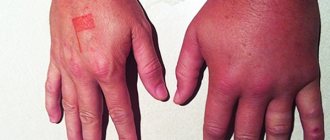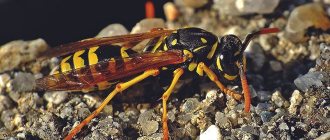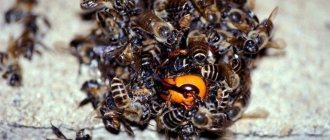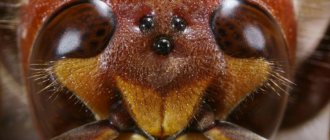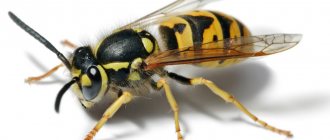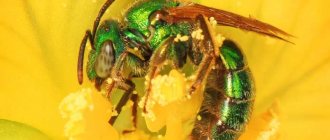Description
Japanese giant
wasp workers feed their larvae. Their diet consists of a wide range of insects, including agricultural pests, and for this reason hornets are considered beneficial. Workers dismember the carcasses of their prey to return only the most nutrient-rich body parts, such as flight muscles, to the nest. There, the workers chew the prey into a paste before feeding the larvae, which in turn produce a fluid consumed by the workers. This liquid is known as Vespa Amino Acid Mixture (VAAM). Synthetic VAAM is currently produced artificially as a dietary supplement, with claims that it can enhance athletic performance. In many Japanese mountain villages, hornet is considered a delicacy when fried.
Bee predation
In Japan, beekeepers often prefer European honey bees because they are more productive than the endemic Japanese honey bees. However, it can be difficult to maintain a captive hive of European honey bees, as giant hornets are destructive to bee hives. Once the Japanese giant hornet has settled into a hive of European honey bees, it leaves pheromone markers around it that quickly attract nest mates to converge on the hive. An individual hornet can kill forty European honey bees in a minute, while a group of 30 hornets can destroy an entire hive containing 30,000 bees in less than four hours. Hornets kill and dismember bees, returning to their nests with bee thoraxes, which they feed on their larvae, leaving heads and limbs behind. Honey and bee larvae are also used to feed hornet larvae.
Unlike its European relatives, Japanese honey bees have protection against hornets. When a hornet approaches a hive to release pheromones, the worker bees will retreat back into the hive, leaving an opening to allow the hornet scout to enter. The bees then emerge from their hiding places in an angry cloud formation containing about 500 individuals. They form a tight ball around the attacking hornets, which acts like a convection oven with the bees vibrating their wings to generate heat through muscle tension and then forcing the heated air around them inwards towards the center of the ball. This causes the ball's internal temperature to rise to 47 °C (117 °F). In addition, the activity of bees increases carbon dioxide concentrations inside the ball. Aspen's ability to withstand heat decreases as carbon dioxide concentrations increase, ultimately causing temperatures to rise to become lethal.
anger
The Japanese giant wasp is large and can be very aggressive if provoked. Its venom, which is injected into its 6.25 mm long stinger, attacks the nervous system and damages the tissues of its victims. Tests involving mice found the venom to be the most lethal of wasp venoms, having an LD 50 of 4.0 mg/kg. For comparison, the lethal wasp venom (at least up to laboratory mice) by mass belongs to Vespa Luctuosa
1.6 mg/kg. The potency of the sting is rather related to the relatively large amount of injected poison. Being stung is extremely painful and may require hospitalization. Asian giant hornet stings can cause anaphylactic shock in people with allergies, but can still be fatal for people who don't have allergies, provided the dose is sufficient. In China, where hornets can also be found, the generally accepted belief is that people stung more than 10 times need medical attention and emergency medical attention if stung more than 30 times. These bites can also lead to kidney failure. Thirty to forty people died in Japan every year after being stung by bees and wasps (including the Japanese hornet).
Insect life cycle
It should be noted that the gigantic size that distinguishes Vespa Mandarinia from more than two dozen of its closest relatives from the genus Vespa is a striking example of evolutionary struggle and the ability of species to adapt to unfavorable environmental conditions.
In addition, in the rich diversity of the animal world, which is typical for tropical countries, large and poisonous insects have a much better chance of finding food for themselves and not becoming victims of natural enemies than their smaller and harmless fellow tribesmen.
Otherwise, the life cycle of these giants is practically no different from that which is characteristic of other species of hornets. Insects live in nests that they build directly on the ground. The material for making the nest is thin and soft (young or, on the contrary, rotten) tree bark, which the female first grinds with her powerful jaws and then glues with viscous saliva. In appearance, such a structure is very reminiscent of paper.
Important! For all inhabitants of areas with hot climates, the possibility of survival directly depends on heat transfer. One method of increasing this is to have a larger body area to provide better cooling.
With the retreat of cold weather, even before starting to build a nest, the queen lays several eggs at the place chosen for the future home and then begins to build a honeycomb house over them. In the first days after laying, the queen takes care of all the nutritional needs of the future offspring on her own. After about a week, a larva emerges from the egg, transforming over the course of another two weeks, first into a pupa, and then into a young hornet.
Further functions of the offspring in the nest are distributed as follows:
- the uterus continues to continuously lay eggs and warm the pupae with its body;
- males - fertilize the eggs and then die;
- working hornets (appear from unfertilized eggs) - obtain food and protect the nest.
Where does it live?
As the name suggests, the habitat of the giant hornet is Asia, more precisely the eastern, and also partly its southern and northern parts.
The list of states whose territory Vespa Mandarinia has chosen for itself includes:
- Japan;
- People's Republic of China;
- Taiwan;
- India;
- Sri Lanka;
- Nepal;
- North Korea;
- South Korea;
- Thailand;
- Russian Federation (Jewish Autonomous Region, Primorsky and partly Khabarovsk Territory).
Did you know? Due to its enormous size, the Chinese called the Asian hornet “tiger bee”, and the inhabitants of the Land of the Rising Sun called it “sparrow bee”.
Good ability to adapt to changing conditions allows Asian hornets to explore different areas of geospace, and yet their favorite habitat is sparse forests, well-lit groves and other areas protected by high vegetation. These insects almost never choose steppes, deserts and highlands to build nests.
What does it eat?
The Asian hornet is practically omnivorous. Its most common food is insects (including smaller hornets), but this giant can just as readily eat fruits, berries, flower nectar, and even meat or fish. Plant food is suitable only for adult hornets, while larvae need products of animal origin.
The hornet extracts food using primarily its powerful jaws; the sting is a tool for protection, not for hunting. Using its jaws, the Asian giant captures prey, kills and then butchers it.
Methods for destroying nests
The greatest harm that Vespa Mandarinia brings to humans lies not in its toxic poison, but in invasions of apiaries. The agriculture of Japan, India and Thailand suffers especially badly from the invasion of killer insects.
Did you know? A dozen Asian hornets can destroy up to 10,000 honey bees in a season.
Consequently, having discovered an Asian hornet nest, people usually try to get rid of such a neighborhood. The problem, however, is that mechanical destruction of the home of a poisonous insect is a dangerous task and, in practice, almost impossible. Hornets are capable of desperately defending themselves and, when faced with the threat of losing their home, unite their forces, regardless of possible losses (protection of the family, by the way, is the most common cause of death for a hornet).
People use special methods to destroy nests of dangerous insects.
For example, for this purpose you can:
- Set fire to the paper house, after pouring flammable liquid over it.
- Fill the nest with boiling water, but you will need a lot of water, at least 20 liters.
- Drown the house in water (this method is used if the nest is attached to a horizontal surface from below, and there is no need to remove it, but you can simply dip it in a bucket of water and support the structure with any support).
- Wrap the structure in a large plastic bag, generously spray a potent insecticide inside and immediately tie the edges of the bag tightly to prevent the poison from escaping.
Important! All work to destroy a hornet nest must be carried out in the dark, when insect activity is minimal. However, you should know that even at night the hornets do not sleep, but continue to work, only periodically, for about 30 seconds, freezing in immobility.
Before starting dangerous work, you should take personal protective measures: wear goggles, a mask, gloves, and even better, a special suit for beekeeping.
The black hornet is a nest parasite
black hornet
The habitat of this species: Primorye and Transbaikalia in Russia, as well as Asian countries: China, India, Burma, Japan and Korea, Thailand. The size of the body is up to 31 mm in females, 22-25 mm in males.
This type of hornet leads an original lifestyle, which allows them to be considered nest parasites. Instead of building their own hive, black females at the end of the summer season try to find a suitable, already built nest of their fellows, usually the European species or small Japanese ones.
Having penetrated inside, the black female kills the queen of the colony and takes her place, camouflaging herself with the help of special pheromones. She lays her own fertilized eggs, and the workers, not noticing the replacement, begin to feed her larvae and serve the new queen.
When the number of mature black females and males has increased sufficiently, they leave the colony and mate. Later, the males die, and the females hibernate in the bark of trees or look for the next nest to establish their home.
Description and characteristics of insect life
Let's get acquainted with the appearance of the Japanese hornet, its behavior and where it can be found.
What does a Japanese giant hornet look like?
This is a subspecies of Vespa mandarinia, a species of the hornet genus of the true wasp family. Its body length exceeds 4 cm, and its wingspan is approximately 6 cm. The insect looks like a large wasp with a yellow head, on which there are large eyes, and the body consists of dark brown and yellow stripes.
Did you know?
Vespa mandarinia or the Asian giant hornet, of which the Japanese subspecies is a subspecies, is the largest hornet in the world, reaching just over 5 cm.
The head, larger than that of wasps, has a pair of main eyes and three additional ones. The tip reaches a length of 6.25 mm, straight, without serrations, reusable. When bitten, it does not remain in the skin. It has large jaws, which it uses for hunting.
Lifestyle and nutrition of the Japanese giant
These are social wasps that build paper nests consisting of pieces of tree bark glued together with saliva. The family is headed by the queen, the only female that is capable of laying eggs. There are working individuals, females, who perform all the work in the hive and outside it (supply), but are not able to reproduce.
There are drones that exist to fertilize the uterus. A family in one nest can contain up to 300 members. These insects feed on nectar and sugary foods. They also hunt other insects and, thanks to their toxic venom and powerful jaws, can take other wasps, grasshoppers, and locusts as prey.
Worker bees do not eat such prey, but simply chew it thoroughly and feed it to the larvae and queen of their nest. Many of the insects they prey on are agricultural pests. Hornets cause considerable harm to honey bees. European bee breeds suffer especially because they cannot resist them.
Did you know?
Japanese bees have their own defense system against hornets.
When a sparrow bee enters their hive, it finds itself in a dense environment of worker bees, which raise the temperature around it to +47°C due to muscular work. Hornets can only withstand temperatures up to +45°C and die after a while, while Japanese bees tolerate body heat up to +50°C.
Habitat
The Japanese hornet is endemic to the Japanese islands, but is also found in the south of Sakhalin Island. Its closest relative, the Asian giant hornet, lives in Eurasia. On the territory of the Russian Federation it can often be found in the Primorsky Territory.
How does it reproduce
Drones fertilize only the queen and do not mate with other females. After mating, they die, and the uterus stores their sperm in itself. She lays eggs in cells. Fertilized eggs produce females, and unfertilized eggs produce males.
First, larvae emerge from the oviposition after about a week, which are fed with protein food from other insects. After a few days, they turn into pupae, placed in a silk cocoon, and the cells are closed with a lid. After a couple of weeks, a new insect emerges from them.
When the uterus ages, other young females can take over its functions. The old queen, unable to lay eggs, is driven away and dies. By winter, working individuals die, and fertilized females look for a wintering place. When it gets warmer, overwintered individuals establish their own colony, laying eggs in self-constructed cells.
The queen feeds the first brood herself, and then all the work, except for laying eggs, is taken on by worker bees.
Did you know?
The queen controls the hornet family using pheromones. Signals from smells force hornets to get food, feed larvae, and attack enemies together.
What does the largest hornet look like?
Those who have ever seen the common European hornet (Latin name - Vespa Crabro) can well imagine Vespa Mandarinia, mentally enlarging the familiar insect by about two times. Otherwise, representatives of these two species look approximately the same, although there are still some minor differences between them.
Did you know? The smallest insect on the planet has a body length of 139 microns, and the largest
-
grows up to 60 cm or more.
The name of the first is Dicopomorpha echmepterygis, the second is Phasmatodea. For clarity, the distinctive features of the Chinese giant and its European relative are given in table form:
| External sign | Vespa Crabro | Vespa Mandarinia |
| Body color | Yellow with thin black stripes | Yellow with black stripes, but thicker |
| Head color | Dark red | Yellow |
| Average body length, cm | 2–3 | 5–5,1 |
| Wingspan, cm | 4 | 7,5 |
| Head | Large | Very large (the width of the eyes is several times shorter than the distance between the outer border of the eye and the temple) |
| Waist | Narrow, although wider than that of a wasp | Wider and proportional to the body |
| Tip length, cm | 0,3–0,6 | 0,8 |
To give a more visual idea of the true size of the Asian hornet, it is enough to say that the length of its body from the top of its head to the tip of its sting is approximately equal to the length of the little finger of an adult man, and its wingspan is only slightly less than the width of a human palm.
The hornet is the largest representative of wasps: description, types, interesting facts from the life of an insect
The Hornet is a member of the Wasp class. These insects create nests by chewing wood fibers and using this material for construction. There are approximately 20 species of hornets on our planet.
Description
What does a hornet look like? In appearance, this insect resembles a large wasp. In the photo of the hornet you can see a large head, on the back of the head of which the organs of vision are located.
The body sizes of insects vary from 20 to 25 millimeters. The abdomen is striped, the wings are thin, the jaws are pronounced and strong, the eyes are large. This is a type of large wasp; these insects inhabit the entire territory of Europe.
Their habitat:
- agricultural plots;
- forest areas;
- grove thickets;
- large shrubs.
They most often build nests under the roof of a veranda, toilet or gazebo, under window openings or stairs. The Asian hornet is not found in our area; this species is considered the most dangerous.
Diet
Hornets prefer to feed on the fibers of rotten trees and stumps. Their favorite delicacy is slightly rotten fruits and berries. They prefer foods that contain large amounts of sugar. They can also eat small insects - bees, grasshoppers.
First, they sting their prey, after which they chew it with their large jaws. Hornets can even attack apiaries, eliminating entire families of bees. The honey aroma is very attractive to them. Some of them can feast on waste meat, fish, and dead insects.
Breeding offspring
With the onset of spring, when the weather becomes consistently warm and sunny, female hornets look for a secluded refuge in order to lay eggs.
Having found a suitable site, the female begins to build a nest. A separate sector is created for each egg. After a few days, offspring are born from the eggs, the young individuals chew the lid and climb out.
When males impregnate females, they die. When the female gives birth, she also dies. Then, closer to autumn, the mating season of young individuals occurs.
Those females that are preparing to breed survive the winter and breed new offspring in the spring. Unfertilized females die. Such a well-coordinated reproduction mechanism allows you to select only strong, healthy individuals who can breed strong offspring.
How insects build nests
We can read more about what hornets do to build a nest. After the adults survive the winter, they establish their own nests when spring arrives.
Females look for safe places inside trees or in wooden buildings. The building material for the nest is recycled wood and crust formations.
After the hornets process the wood, a material appears that resembles thin papyrus. From this substance the nest is further created.
Its shape can be round or oval. Attachment occurs using the salivary fluid of insects. Once dry, it hardens and serves as “cement.”
These insects have a hard time withstanding the winter; careful preparation is carried out before the onset of cold weather. Hornets build nests deep in shelters, after which the queen goes into hibernation. A large number of insects die in winter, when temperatures are too low and in the absence of snow.
Hornet sting
After this insect stings a person, the damaged area swells sharply and severe pain occurs. Their bites are deep, and the wound can take more than a week to heal.
The toxins contained in the poison can cause a powerful allergic reaction in the human body, which is accompanied by:
- dizziness;
- nausea;
- severe swelling;
- fainting;
- anaphylactic shock.
Fighting hornets
How to get rid of a hornet worries many people who encounter nests of these insects in their areas.
First you need to find the nest. Next, you need to thoroughly treat the bag with a chemical insect repellent and put this bag on the nest. If the nest is high, tie the sprayed bag down below.
Many people pour kerosene or other flammable liquid over the nest and then set it on fire. Such actions are dangerous because they can cause a fire.
This should absolutely not be done indoors. If a nest is found, it is necessary to hang a container with a solution of boiling water and kerosene from the ceiling, and then lower the nest into this container. You can also fill the honeycombs with polyurethane foam. This will keep the insects trapped.
Bite symptoms
First of all, the bite of an Asian hornet is very painful. According to one of the victims, the sensation is reminiscent of being pricked by a hot nail if you step on it with all your weight. The pain does not go away for a long time and is pulsating in nature.
External signs of a bite are:
- redness of the skin in the affected area;
- rapid spread of inflammation to a wider area of skin;
- the appearance of swelling;
- thickening of the tissue around the bite site;
- swollen lymph nodes;
- hyperthermia, fever.
As the toxin enters the bloodstream, a person may feel:
- shortness of breath, difficulty breathing;
- dizziness, up to loss of consciousness;
- headache;
- nausea, sometimes ending in vomiting;
- rapid heartbeat (tachycardia).
Important! If you have an allergy or multiple bites, the Vespa Mandarinia venom can cause anaphylactic shock and be fatal to humans. So, according to statistics in Japan, up to four dozen people die every year from the bite of these insects.
How do hornets winter?
Almost all members of the hornet colony die before the onset of winter. Only fertilized young females will remain. During the last warm days, they actively hunt, replenishing their body’s energy reserves. A decrease in daylight hours becomes a signal for the onset of diapause. This is a condition in which the body's metabolic processes are inhibited.
Where do hornets winter? They choose secluded places where they can hide from severe frosts and natural enemies - birds and mammals. Females prefer to climb under the bark of trees; the deeper they are, the greater their chances of surviving until spring. For wintering, tree hollows filled with fallen leaves, crevices in sheds, and attics are used. Females will wake up in May, when the average air temperature does not drop below 10. They will live the longest - 1 year and create a new family of common hornets.
Invader Queens
This insect is unique among all other hornets in that it parasitizes the nests of its fellows:
- At the end of the summer season, the female black hornet looks for a hive of some small species of hornet, fights her way into it and destroys the queen. As a rule, only a few succeed, since soldiers and workers fiercely and completely protect their womb and will never recognize a new womb while the old one is alive. Of course, the individual that was able to capture the nest contributes to the emergence of new black hornets, which more than compensate for the death of the males and females of this species.
- Using special pheromones, the female black hornet, like a chameleon, disguises itself as representatives of another species. The workers determine by smell that this is their queen, whom they serve, and, as if nothing had happened, they continue their work of providing the nest with food and building material.
- After this, the female begins to lay eggs, from which larvae soon hatch. Working individuals, suspecting nothing, feed them until they become adults and ready to reproduce.
- Then swarming and mating occur. The males die, and the fertilized females fly away in search of new nests on which they can parasitize, or, if the cold season is ahead, they look for shelter for the winter.
Very rarely, black hornets build a hive and live together. This behavior is explained by the fact that in the area where they live, there is no one for them to parasitize, so the search for other people’s nests can end in failure and lead to their extinction.
Why is a bite dangerous?
Due to the fact that this insect is a parasite, its poison is stronger than that of its relatives, which are widespread in Russia. This is due to the fact that the female black hornet must kill her rival when capturing someone else’s hive.
Since her opponent belongs to the same family as she does, she is, accordingly, immune to the usual poison of representatives of related species. Therefore, to eliminate the enemy, nature awarded black hornets with additional toxins, allowing them to achieve their goals.
After being bitten by this insect, a person experiences the following symptoms:
- sharp throbbing pain;
- inflammation of the affected tissue at the site of the bite, accompanied by itching;
- dyspnea;
- cardiopalmus;
- headache;
- swelling of the mucous membranes;
- allergic reaction to a bite;
- Quincke's edema is possible;
- very rarely, in 5-6 percent of recorded cases, the consequence of a bite is anaphylactic shock, which ends in death without medical attention.
First aid for a bite:
- An ice compress on the affected area is required.
- To prevent an allergic reaction, take an antihistamine, such as prednisolone or suprastin.
Go to the hospital immediately if you have a high temperature, swelling of the mucous membranes, dizziness or headache, remember that in about 5 cases out of a hundred, a bite can result in death without medical intervention.
Help with a bite
The first thing that can be done for the victim before the ambulance arrives or goes to the doctor on his own is generally similar to providing assistance with a bite from other types of hornets:
- check if the sting remains (if the hornet was swatted at the crime scene);
- disinfect the wound with hydrogen peroxide or weak potassium permanganate;
- apply cold to the bite site;
- call a doctor.
If you provide the victim with really fast medical assistance, most of the serious manifestations and consequences of a giant Asian hornet sting can be avoided.
Hornet sting: harm of poison and consequences of toxic effects
The bite of this insect is more painful than a bite from a bee or wasp. It all depends on the individual body’s ability to tolerate pain. If a sting occurs, it is advisable to help the person as quickly as possible. Hornets have a needle with which they can pierce the human body repeatedly. Individuals from Asia are more poisonous than European ones. The bite is accompanied by sharp pain with severe swelling. May cause: severe pain and hemorrhage followed by suppuration.
Does the hornet bite or sting?
The hornet has powerful jaws. His bites are very deep. The wounds take almost a week to heal. When attacking a person, hornets use a sting that leaves scars in the form of dots, but they can also simply bite with their claws. The poison is dangerous because it is toxic and can poison the body. The bite is very painful and the consequences can be unpredictable. Elderly people, children and allergy sufferers are especially at risk. Swelling and inflammation can appear instantly after an insect attack, and suppuration is also possible. Signs of poisoning are characterized by nausea and severe dizziness.
Bites pose the greatest danger to those people who have an allergic reaction. They can worsen a person’s condition from several hours to 2-3 days. The bite is dangerous because the body of a person with allergies does not fight well against the effects of the poison. As a result, large swelling and difficulty breathing may occur. In some cases, people lose consciousness. The insect venom contains histamine, which most often causes a person to feel unwell, up to and including anaphylactic shock. Fatalities are caused by neglect of medical care and delayed first aid.
What does it eat?
The Japanese giant hornet feeds on many foods and is considered a hardy insect. Sweets are most suitable, including fruits, berries and honey. In addition, they kill insects for food, including flies, butterflies, locusts, bees and other representatives. They do not disdain eggs, from which new insects only emerge.
Hornets have powerful jaws, which they use to kill their prey. After this, processing with saliva, chewing is carried out and this product belongs to its family. Adult hornets do not eat insects, but only get them. Only larvae eat meat, fish and other animal foods. To obtain food, hornets almost never use a sting with poison.
Tips on how to get rid of hornets
Hornets are dangerous to humans, but they also eat many insect pests, which benefit the garden. Therefore, it is recommended to destroy their nests only as a last resort, when these insects have settled very close to the house or near a bee apiary.
You can get rid of these insects using various methods listed below:
- If a hornet has flown into an apartment, you should not drive it out with your hands or try to slam it with a towel, as the insect will perceive these actions as a threat and will attack. It is better to wait until it sits on a flat surface and cover it with a glass jar. Then the neck of the container must be carefully closed with a lid and taken outside so that the individual flies out of the jar.
- To scare hornets away from your garden plot, you can hang a pod of red hot pepper near their nest.
- A decoction based on boric acid will help destroy a small number of insects. To 200 ml of water you need to add crushed fly agaric mushrooms (2-3 pcs.) and 1 tbsp. l. boric acid, then boil the mixture on the stove for a few minutes. Cool the resulting poison and pour it into small containers, adding a little honey to it as bait.
- You can install traps made from plastic bottles. The top of the bottle must be cut off, turned over and inserted neck down into the remaining lower half of the container. Pour honey or jam into the bottom of the trap as bait so that insects fly inside through the neck and cannot get out.
- Hornets are repelled by the pungent aroma of some plants. To drive away insects, you need to plant geranium, lemon balm or mint on the site.
- If you fill a bucket with water and place it on a stepladder so that the nest is at least partially submerged in water, then all members of the family will get wet and die.
- You can pour a large amount of boiling water over the nest so that it gets on all parts of the structure. When exposed to high temperature water, all individuals will die.
- To exterminate the entire family, you can seal the entire surface of the nest and its main opening using foam. It will block the insects' access to oxygen and light, resulting in all individuals suffocating. After this, the nest can be removed and destroyed.
- You can pour gasoline on the nest and then set it on fire. Fire will completely destroy the hornets, but this method cannot be used if there are flammable objects nearby or the nest is located under the roof of a house.
- If the insect nest is in a hard-to-reach place, then you can light a special wasp smoke bomb nearby. During smoldering, it releases poisonous permethrin, which kills insects.
- To drive hornets out of your area, you can install an ultrasonic insect repeller. It produces sound waves that are not perceived by the human ear, but have a negative effect on hornets.
- To exterminate these insects, there are store-bought chemical insecticides (Dichlorvos, Karbofos, Raptor, etc.). This product should be sprayed onto the inside of a plastic bag, and then put on the socket and secured with tape or thread.
Important! To avoid bites, all actions to get rid of insects should be carried out at night. In this case, it is necessary to use protective gloves, thick clothing and a face net. Hornets are very interesting insects that have a complex caste hierarchy
Due to their large size and the presence of poisonous glands, they can pose a danger to other insects and humans. A detailed description of hornets presented in this article will help to better study the lifestyle of these insects and effectively get rid of them if there is a threat
Hornets are very interesting insects that have a complex caste hierarchy. Due to their large size and the presence of poisonous glands, they can pose a danger to other insects and humans. The detailed description of hornets presented in this article will help to better study the lifestyle of these insects and effectively get rid of them if there is a threat.
Huge Asian Hornet
In the world of animals and insects there are sometimes bizarre or terrifying specimens. One of the insects that can instill fear in humans is the Asian giant hornet. Its name comes from the Latin “Vespa mandarina”. The Asian giant hornet is the largest hornet in the world, measuring five centimeters or more and having a wingspan of more than seven and a half.
The habitat of the Asian giant hornet is Korea, China, Taiwan, Nepal, India, Japan, and the mountainous regions of Sri Lanka. Here this insect can be found everywhere. In addition, Asian giant hornets live in large numbers in the Primorsky Territory of the Russian Federation.
The Asian giant hornet is called differently in different countries. For example, in Taiwan it was called the “tiger bee.” It really has a color like a tiger - black stripes on the yellow body of an insect. Apparently, the size of the hornet also played a role in this name. In Japan, the Asian huge hornet was called the “sparrow-bee”. This name is given due to the large span of its wings.
The sting of the Asian huge hornet reaches 6 millimeters in size. The venom produced by its sting is highly toxic. That is why the bite of the Asian huge hornet is very dangerous for humans. In terms of toxicity, the bite of the Asian giant hornet is many times more dangerous than the bites of other hornets, since the bite releases an impressive amount of poison. One Japanese entomologist, who was bitten by an Asian giant hornet, compared the sensation of the bite to a hot nail piercing his leg.
People who are allergic to bee and wasp venom should be wary of the bite of the Asian giant hornet - it is deadly for them. The venom of the Asian giant hornet contains a high concentration of a toxic substance - mandorotoxin, a large amount of which can kill even a completely healthy person who is not allergic to wasp venom. Thus, repeated stings or stings from large numbers of Asian giant hornets can be fatal to any person.
In addition to mandorotoxin, the venom of the Asian huge hornet also contains other toxic substances that can destroy the tissues of the human body, cause terrible pain, and, worst of all, attract hornets. Acetylcholine, contained in the venom of the Asian giant hornet in an amount of more than 5%, has the ability to attract other hornets. The Asian giant hornet, like the wasp, can use its sting repeatedly.
However, when hunting, the Asian huge hornet uses its jaws, which are quite large and developed. Having grabbed prey with its jaws, the huge Asian hornet crushes its victim with its jaws.
Well, in conclusion, a video of an epic battle... 30 Asian hornets destroy a 30 thousandth colony of European bees...
What do hornets eat?
Adult hornets feed mainly on plant foods, especially those rich in sugar. Very often, insects can be observed in orchards during the active ripening of fruits, sitting on soft, overripe fruits (apples, pears, plums). Hornets happily feed on the sweet secretions of aphids and nectar, they love to feast on honey, so they often attack apiaries and drink the sap flowing from the wounds of trees (aspen, oak, ash, elm). In addition, hornets are excellent hunters: their victims include grasshoppers, flies, spiders, dragonflies, small locusts, butterflies, crickets, bees and their larvae, beetles, caterpillars and close relatives of hornets - wasps. For example, during their life cycle, tropical hornets can destroy more than 500 colonies of bees and wasps. By the way, the two-colored hornets Vespa bicolor, which live on Hainan Island, sometimes mistake orchid flowers for bees and attack them. It's all about the unusual aroma, similar to the smell of a honey bee, which attracts predators.
Killed by powerful jaws and stings, the prey is thoroughly moistened with saliva and chewed into a suspension, but is not at all a source of nutrition for the adult hornet, but is used to feed the voracious larvae during their growth period. In one day, a large colony of hornets can feed up to 500 grams of insects to their larvae. Some hornets, such as the Dybovsky hornet, in addition to catching live prey, search for dead insects and also collect human food waste, not disdaining meat and fish. All this also goes into food for the larvae.
Are they beneficial or harmful?
Insects of this family are not particularly dangerous to humans. They bite on rare occasions, but the venom is weaker than that of other wasps and bees. In general, Scolia is an insect useful for agriculture, despite the fact that it is a predator. It destroys pests of different crops.
Scolia larvae bring significant benefits, since they infect the offspring of harmful insects. However, adult individuals are also effective in the fields, as they pollinate plants: they feed on nectar and pollen. They only do this selectively, because the structure of their body does not provide for the ability to penetrate into the deep corollas of flowers.
Interesting video: The real monster is the Scolia wasp
Bite danger
Contact with any wasp (paper wasp, black hornet, etc.) can lead to the development of an allergic reaction. A single injection of a toxic substance is not enough to develop serious consequences, and one cannot expect an attack by a large number of scolias, since they live alone
However, caution should be exercised if an insect of this species is found nearby. Its bite is quite painful
In addition, a similar reaction may occur as after contact with an encephalitis tick.
With increased sensitivity of the body, a severe allergy develops as a result of the bite of one adult wasp, but this happens much less frequently. Possible symptoms upon contact with scolius: dizziness, convulsions, vomiting, arrhythmia. The worst case scenario is anaphylactic shock.
The victim may lose consciousness. People of certain groups are at risk:
- Children;
- Pensioners;
- Pregnant women;
- Suffering from asthma, allergies, diabetes.
The main reason for a Scolia bite is self-defense. This means that direct contact with insects should be avoided.
What to do if you are bitten?
First aid measures for an Asian hornet sting are similar to those that need to be taken for a wasp victim, with the only difference being that you need to act even faster.
List of urgent actions:
- lay the patient on his back so that his head remains elevated;
- give an injection of an antihistamine, preferably a hormonal one (Prednisolone, Dexamethasone, Betamethasone, etc.), or, as a last resort, take a tablet orally;
- disinfect the bite site with hydrogen peroxide, alcohol or iodine solution;
- apply cold to the bite site;
- if possible, make a sugar compress to slow down the process of absorption of the poison into the blood;
- deliver the victim to a medical facility as quickly as possible (however, if the condition does not clearly worsen, and the person does not suffer from a severe allergy to insect bites, you can risk doing without a doctor).
The Asian hornet is an insect whose bite is fraught with serious consequences, including death, but such cases are still rare. Moreover, if the usual precautions are taken, the likelihood of becoming a victim of Vespa Mandarinia is not that great, since by attacking, the insect is really just protecting itself from danger, real or imaginary.
